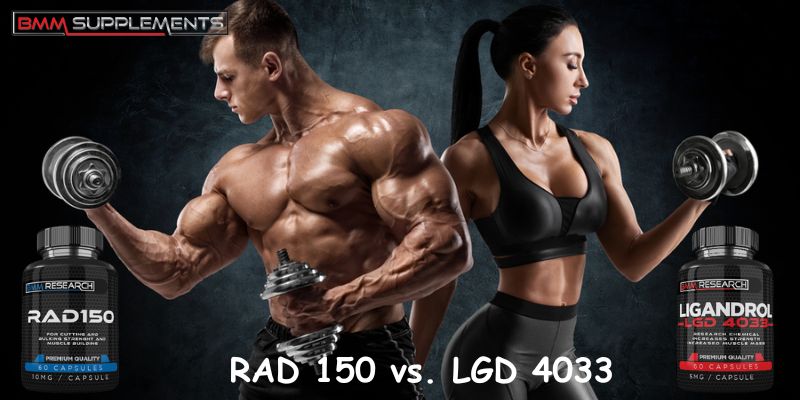- info@bmm-supplements.com
- +31-(0) 85 7430610
- Olympia 2d, 1213 NT Hilversum Die Niederlande

In recent years, the world of fitness and bodybuilding has witnessed a surge in the popularity of Selective Androgen Receptor Modulators (SARMs). These compounds, often touted as a safer alternative to traditional anabolic steroids, have garnered attention for their potential to enhance muscle growth, increase strength, and improve overall athletic performance. Among the numerous SARMs available, RAD 150 und LGD 4033 are two that have gained considerable prominence. In this comprehensive guide, we’ll delve into the world of RAD 150 vs. LGD 4033, exploring their similarities, differences, potential benefits, and potential risks.
Before diving into the specifics of RAD 150 and LGD 4033, let’s take a moment to understand what SARMs are and why they have gained popularity. Selective Androgen Receptor Modulators are synthetic compounds designed to target and activate specific androgen receptors in the body. These receptors are primarily responsible for regulating muscle and bone growth, fat metabolism, and other crucial physiological processes.
One of the key selling points of SARMs is their selectivity. Unlike traditional anabolic steroids, which often lead to a range of unwanted androgenic side effects, SARMs are designed to target only specific receptors in the body, minimizing potential harm. However, it’s essential to note that SARMs are still under research, and their long-term effects are not fully understood.
LGD 4033, also known as Ligandrol, is one of the most well-known SARMs on the market. It was initially developed to combat conditions like muscle wasting and osteoporosis but has since found its way into the hands of bodybuilders and fitness enthusiasts seeking gains in muscle mass and strength.
RAD 150, also known as RAD-150 or TLB-150, is a relatively new entrant in the world of SARMs. It has been developed to target androgen receptors with even greater specificity, potentially making it a safer option compared to LGD 4033.
Now that we’ve explored the potential benefits and risks of both RAD 150 and LGD 4033, let’s draw some comparisons between these two SARMs.
One of the fundamental differences between RAD 150 and LGD 4033 is their selectivity for androgen receptors. RAD 150 is designed to be even more selective, potentially minimizing the risk of off-target effects. However, it’s important to note that individual responses can still vary.
Both RAD 150 and LGD 4033 are believed to be effective at promoting muscle growth. Users have reported substantial gains in lean muscle mass with both compounds. However, the extent of muscle gains may vary based on factors such as dosage, diet, and training regimen.
Both SARMs have the potential to disrupt natural hormone production, primarily by suppressing testosterone levels. This is a significant concern, as hormonal imbalances can lead to various side effects, including mood swings, fatigue, and libido issues. Users should be prepared to implement PCT if necessary to restore hormonal balance.
Both RAD 150 und LGD 4033 have been associated with improved athletic performance. Users often report increased strength and endurance, which can be beneficial for athletes and bodybuilders alike.
Perhaps the most crucial point to consider when comparing these two SARMs is the lack of comprehensive long-term research. The absence of such research makes it challenging to definitively determine the safety and potential risks associated with their use.
It’s essential to approach SARMs with caution and awareness of potential risks. Here are some key considerations:
. PCT typically involves the use of compounds like SERMs (Selective Estrogen Receptor Modulators) to stimulate the body’s own production of testosterone. Consulting with a healthcare professional knowledgeable about SARMs can help you develop an appropriate PCT plan.
In the world of fitness and bodybuilding, RAD 150 and LGD 4033 have emerged as two of the most popular Selective Androgen Receptor Modulators. Both compounds show promise in promoting muscle growth and enhancing athletic performance. However, it’s essential to approach their use with caution and awareness of potential risks.
The limited long-term research on RAD 150 und LGD 4033 means that their safety and efficacy are not fully understood. Users should be prepared for the possibility of hormonal disruption and consider implementing post-cycle therapy to mitigate these effects.
Ultimately, the decision to use SARMs should be made after careful consideration of your individual goals, health status, and the legal regulations in your area. Consulting with a healthcare professional who is knowledgeable about SARMs can provide valuable guidance and ensure that you make an informed choice.
As the world of SARMs continues to evolve, it’s essential to stay updated on the latest research and regulations. Always prioritize your health and well-being above short-term gains, and remember that there are no shortcuts to achieving lasting fitness and strength.
Disclaimer: This article is for informational purposes only and does not constitute medical advice. SARMs, RAD 150 and LGD 4033 are NOT meant or approved for human consumption and can only be bought for research purposes
